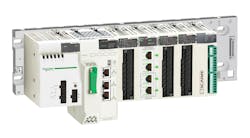Ethernet has Become the DNA of Industrial Environments
FDT helps extend networking links from highest to lowest levels.
Most networking scenarios for the automation industry is built around linking all devices/systems using Ethernet and IP protocols. Beyond direct integration into the control processor, Ethernet is also the backplane of the Ethernet Programmable Automation Controller (ePAC), in parallel to the previous system bus, the X-Bus.
This architecture ensures backward compatibility for existing I/O families. Existing applications can be migrated to the new system without changing any wiring. Also, software consistency is ensured with the programming tool Unity Pro. The automation platform Modicon M580 represents a controller which is built on Ethernet.
The use of fast Ethernet with 100 Mbit/s within the CPU and the backplane allows flexible architectures for different applications and industry sectors. By default, this platform supports EtherNet/IP and Modbus TCP allowing a standardized integration of modules directly into the backplane also for cooperation partners.
The controller offers a service port enabling comprehensive diagnosis possibilities. For example, port mirroring permits recording the data/communication of both Ethernet ports, the backplane, or all elements.
Depending on the plant topology, flat and/or hierarchical structures can be managed including gateways to different fieldbus systems. The necessary device management for such topologies is provided by FDT Technology, allowing managing different devices in various network/fieldbus systems using one engineering tool.
FDT Technology as standard method for device management
FDT is an integral part of Unity Pro, an engineering tool that includes an embedded FDT Frame Application component. It provides all the necessary interfaces for a consistent device management for devices from Schneider Electric as well as for modules from cooperation partners and third party devices. Users therefore have a consistent method independent from the device vendor and the connected network/fieldbus systems.
Additional features ease the workload of users: when a Device Type Manager (DTM) is created in the topology, the tool automatically generates the data structures for direct use by the PLC programmer. If the Device DTM supports process data the appropriate PLC variables are created independent of the network/fieldbus type to which the device is connected. For such cases, the FDT2 specification now contains definitions introduced to be used in factory automation applications (“PLC Tool Interface“).
A network/fieldbus independent interface is defined to obtain the data from the bus master creating the PLC variables automatically.
Toolkit for partner modules
To ease the work of partners who are integrating application module into the Ethernet backplane, the PME toolkit is offered (Partner Module for Ethernet backplane). It comprises an Ethernet and base PCB for the partner application. A generic DTM is provided for integration into the engineering tool.
This DTM interprets the device description (written in DDXML: Description eXtensible Markup Language). To create this description, the partner gets an Excel template where he fills in the device parameters. Out of this Excel sheet the DDXML file is generated. The first partner module developed with the toolkit was a weighing module from our partner Scaime.
For more information about the Modicon M580, please click here.

